This is a guest post by Darren Davis. It originally appeared on his excellent blog, Adventures in Transitland, which we encourage you to check out. It is shared by kind permission.
Like the Otago Gold Rush of the 19th Century, its 21st Century counterpart, the gondola rush, has come to town in Queenstown. What is it and will it work?
Let me start by stating the obvious. Queenstown already has a gondola in the form of the Skyline Gondola that ascends from the town centre and affords spectacular views from its top station.
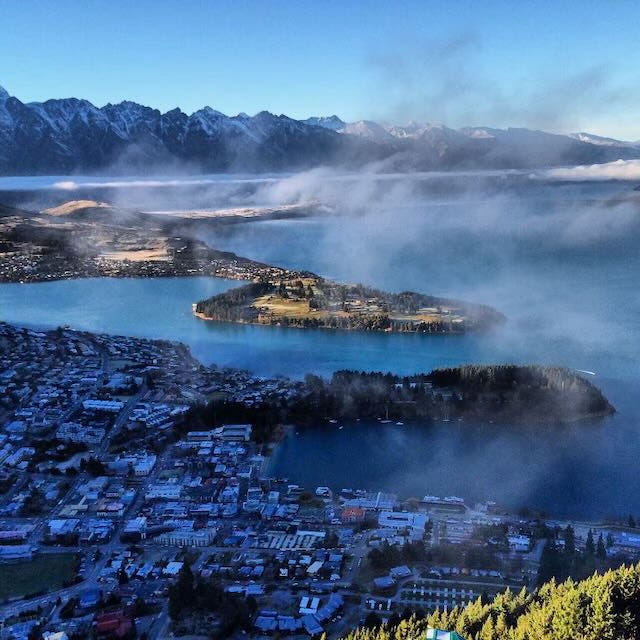
This is a classic situation where gondolas work because they ascend a 170 metre steep slope to Bob’s Peak that would be very difficult by achieve other means, and separate willing visitors from $66 of their money to give them those spectacular views and get them back down again. While you can climb the Tiki Trail to the Gondola Top Complex, this is only recommended for the seriously fit.
This use case for gondolas brings us to the similar but much more intensively used use cases than mountain ascents for skiing, snowboarding and general sightseeing. This is their use in Latin American cities where, unlike the more general situation, the poor tend to live in informal settlements clinging precariously to hillsides while better off people live on more solid ground in the valleys below. La Paz is a particular case in point given its high altitude with the city at 3,650 metres above sea level and its poorer communities in El Alto at 4,000 metres above sea level where it is getting decidedly difficult to breathe. El Alto is poorly connected by narrow, winding, congested roads for the steep descent into La Paz where most jobs and educational institutions are located. Conventional public transport gets stuck in this same congestion. The response to this is Mi Teleférico. According to Wikipedia “the system consists of 26 stations (36 if transfer stations are counted separately per line) along ten lines… Further lines and extensions are in planning or construction”
It is now the world’s largest gondola network and has transformed public transport in La Paz, addressed glaring socio-economic inequalities and reduced air and noise pollution. This is the poster child for gondolas done well as public transport. Its Spanish tagline “superando límites”/ “overcoming barriers” is decidedly apt.

Closer to home in Aotearoa, the same outfit, Doppelmayr, which implemented the La Paz network are pitching a similar network for Queenstown, arguing on similar grounds around topography and constraints in the roading network. And Woosh are pitching a different version of the same model. As anyone who has been to Queenstown of late can attest, the congestion is real and the single biggest negative to what is otherwise a stunning year-round visitor destination. But the congestion is the product of New Zealand’s fly and drive tourism (and general transport) model. Most visitors head straight for the rental car and camper van counters at Queenstown Airport while those in the know head to the bus stop for the all-day, every day frequent bus into town that costs just $2 on a Bee Card (and eventually a nation-wide Motu Move card).
In fact, Queenstown’s bus system fares remarkably well in a town with only 28,600 people (Stats NZ, June 2024). In the nine months to March 2025, Queenstown’s public transport carried 1,489,729 trips. This equals 70 trips per capita year, similar to Wellington (but conveniently forgetting the much higher proportion of visitors in Queenstown). This isn’t bad for a network stuck in the same grinding congestion as all the other traffic.
It’s clear that Queenstown cannot build its way out of congestion and not for want of trying. It has just spent $128 million the first stage of a town centre bypass, made up of around 350 metres of new roading connecting a couple of previously disconnected streets which were in turn upgraded. It took four years of major disruption to build and ran $40 million over budget. The Press described it as “Queenstown’s controversial $130m ‘road to nowhere’” and no funding is in sight to actually complete all stage of the bypass. Which is of limited value anyway given that only a very small proportion of traffic actually passes through the town centre with the vast majority of trips terminating in the town centre itself.
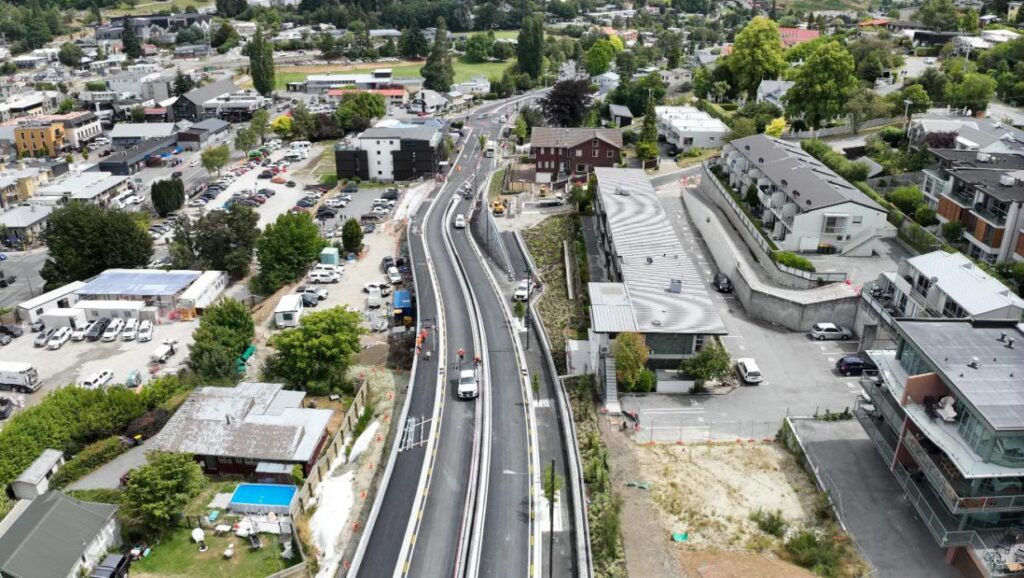
Not content with this, the New Zealand Transport Agency is doubling down on roading in Queenstown with $250 million committed to upgrading the notorious BP Roundabout at the intersection of state highways 6 and 6a, a modest upgrade to the Frankton Bus Hub and a new roundabout where State Highway 6 meets Howards Drive.
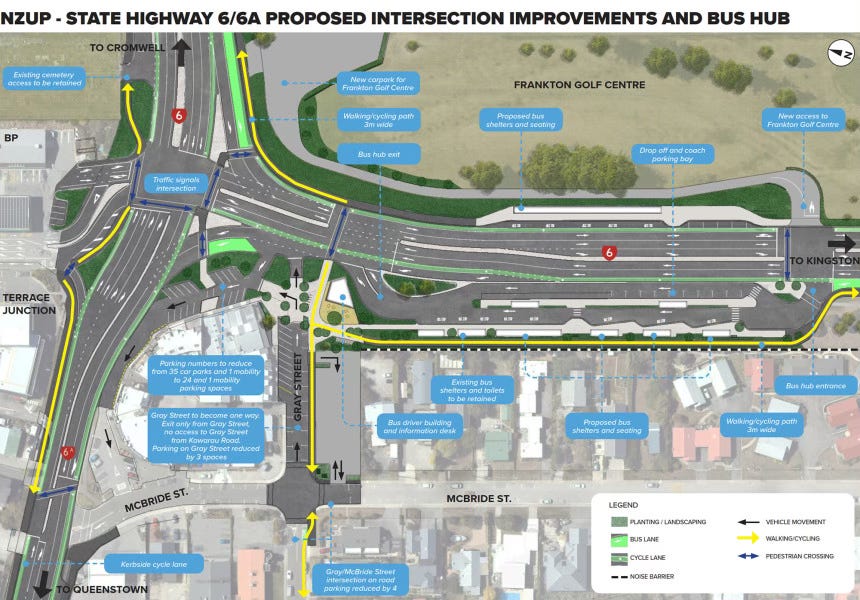
So it’s clear that it isn’t money that is the problem. It is how it is being spent and where the road space is going to. The light green kermit above shows the extent of bus priority at Queenstown’s busiest and most congested intersection and a major pain point for existing bus operations.
So enter stage left the gondoliers. Their solution is simple. To go above the congestion and give people a congestion-free journey. Sounds great, doesn’t it. Until you think through the detail. Which Nicholas Reid did in thought-provoking detail in his piece, Gondolas for Mass Transit, on Greater Auckland. I highly recommend reading his piece but the TL:DR is in his conclusion “But overall, it’s clear that cableway transit is something that works well where it works well (like climbing mountains), but it’s not a replacement for most regular bus or rail transit routes. It’s a niche option, and that niche seems even smaller than you might think”
One of the gondola backers, Ross Copland, inadvertently gives way one of the key downsides of the Doppelmayr backed gondola proposal in this Radio New Zealand piece: “It’s almost a direct route into Queenstown, but importantly it bypasses a lot of those residential areas where the visual effects would be quite significant.” The whole point of public transport is to serve land use, not actively avoid it to avoid NIMBY complaints of aerial trespass.
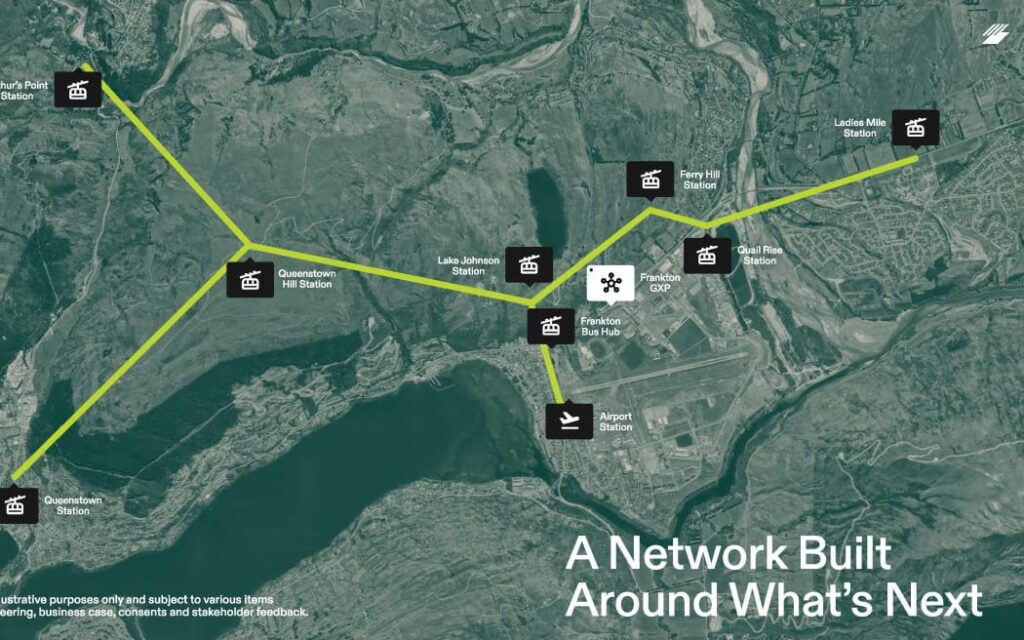
But apart from that is the question of speed. A typical gondola travels at 6 metres per second but has to come down to a near halt at stations so that people can get on and off. Which begs the question of how people will get on and off with luggage, pushchairs, wheelchairs, skis and snowboards. All things that are a regular feature of a year-round resort destination. At best you are likely to get an effective speed of 12 kilometres per hour so you are likely to look down from your gondola and see yourself being overtaken by people on lime scooters and bicycles which have higher average speeds.
The gondola network shown would most likely requiring changing at key points as gondolas are typically point-to-point. In addition, they do not deal well with peaks and this is an issue even with relatively high capacity systems like La Paz. There are long waits around school and work start of finish times given that capacity is fixed. Which is great at 11pm when waits would be minimal but not so great at 8am when you need to get to work or school on time.
Which brings me back to the humble bus, which does remarkably well in Queenstown but is hampered by a lack of priority and the very unusual peaks of a tourism destination – for example outbound 10am when visitors have had their breakfast and inbound in winter around 4pm when ski slopes start to close.
Taras Grescoe has recently written about the Roam bus network in Banff, Alberta, Canada. This is very similar to Queenstown. The service area of Banff and Canmore have a combined population of 23,000; it’s an extremely popular year-round resort destination; the buses cost $2 and it carries 2.7 million people a year. A tad more than Queenstown but not that much. In both Canada and New Zealand, it’s the humble bus that gets you close to where you want to go (and not swooping above where you want to go) but in both cases, a lot more priority would go a long way to making public transport the mode of choice of Queenstown. Which would cost a lot less and make Queenstown a lot more pleasant than continuing to double down on roading. or dreaming big on miscellaneous gadgetbahns.
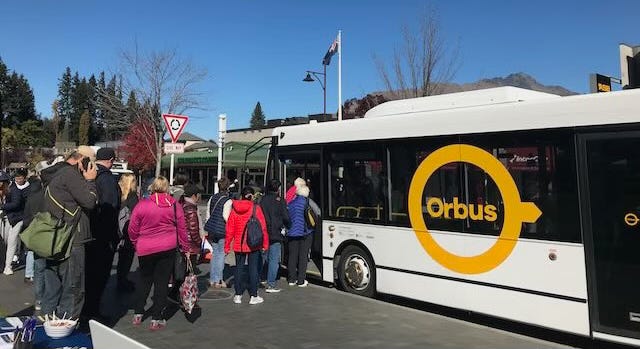
The humble bus, prioritised at traffic signals and congestion hotspots, with boosted frequency and maybe even 24-hour operation, is just what what the doctor ordered to cure Queenstown’s traffic woes. And it doesn’t cost the earth, take years on end to deliver and provides real benefits to real people sooner than the futile quest to build Queenstown out of congestion.
This post, like all our work, is brought to you by the Greater Auckland crew and made possible by generous donations from our readers and fans. If you’d like to support our work, you can join our circle of supporters here, or support us on Substack!

 Processing...
Processing...
Cars do quite well in Queenstown. Or as the call them down there “emergency housing”.
For the kind of money these road schemes are costing, you could rebuild the maunga at Wiri and run indoor skiing by the airport all year round.
It would save reproducing the road environment of Manukau and keep Queenstown charming, exclusive and expensive.
” Which begs the question of how people will get on and off with luggage, pushchairs, wheelchairs, skis and snowboards. All things that are a regular feature of a year-round resort destination. At best you are likely to get an effective speed of 12 kilometres per hour so you are likely to look down from your gondola and see yourself being overtaken by people on lime scooters and bicycles which have higher average speeds.”
Modern Gondola/Chairlifts detach and then reattach from the cable at stations to slow down, once on the cable the speed is 6m/s (~20km/h)…getting on with luggage/buggies/ or skis etc is not a problem…
But TBH the interest in cableways in Queenstown is a symptom of the fragmented transport system (and governance from a distance)..along with locals believing that they have been ignored,
The Bus network is run by the Otago Regional Council, with pretty much all the transport department in Dunedin, the current SH6/6a intersection upgrade is managed by NZTA again certainly not based in Queenstown,
Then there is the local council that is stuck with getting it in the ear from local residents every day but have little power to actually do anything…
( The “Road to Nowhere”- Melbourne St bypass- is a function of this, its basically came about because central government was spraying money around during COVID with short deadlines to plan things, the Council had mooted this project for years, but it never go built because no one could see any huge benefit from it)
Locals have already voted with their feet and there is no actual need to go into Queenstown centre for any day to day activities, all the shopping/banking/amenities are all at 5 mile/Frankton….
There is pretty much no more housing being built in places like Fernhill, its all going happening at Ladies Mile and south by Hanleys farm and Jack’s point…
Agree, although the council doesn’t do itself any favours with density restrictions in the old Queenstown/Fernhill area. It probably made sense in the 1970s to restrict development to preserve views but it doesn’t any more.
There’s a saying: “In a gold rush, sell shovels.”
Can we also say: “In a gondola rush, sell gondola plans.”
I agree with Darren. Bus priority and increased frequency would deliver a much better service, serving more people.
If the Simpsons “Monorail’ episode taught us anything it is that local authorities are attracted to new, shiny “wow ” options. Bus priority and better frequency is what would work- maybe they just have to add that the buses will all feature designs of local landmarks. “Come to Qtown and collect the set on our new buses- ‘ Bungy” , ” Remarkables and yes even Gondola!”
Incidentally the humble 25B bus from Mt Roskill to Aotea Centre takes 32 minutes to travel 6.3km at a speed of 11.81 km/h, so you are likely to look out from your window and see yourself being overtaken by people on lime scooters and bicycles which have higher average speeds
24/7 bus lanes and light priority, when?
Yes, I’ve seen bicycles overtaking that bus, only to be seen again as a figure in the distance.
Only if they had to stop at the Balmoral intersection would the bus sort of catch up with them.
And, of course, the cyclist would use Ian McKinnon Dr whereas the bus would turn into View Rd to continue its crawl.
Of course it would be pretty easy to fix as there are so many glaring issues, but the boffins at AT are blind to projects that don’t cost billions (or those that reduce the business case for pet projects that do cost billions):
1) 24×7 bus lanes (like LR)
2) Use Ian McKinnon Drive (like LR)
3) All door boarding (like LR)
4) Reduce right turns to/from Dominion (like LR)
5) Traffic light priority (like LR)
6) Continue down Queen Street to Britomart, bus only (like LR)
7) Reduce the number of stops (like LR)
8) Use articulated buses instead of double deckers (like LR)
Not sure why the vehicle needs steel wheels for these options to be implemented…
Yes they could do a lot of this, but there are a few things that only work with light rail, like 4 (right turn tracking for utirns around central tracks is great, not for side bus lanes) and 5 (signal priority doesn’t work when you’ve got a bus on every signal). 3 and 8 are hard with tracking to kerb side stops.
What a monster of an intersection at Frankton … I can hear the workshops and discussions:
“Can we add any bus lanes”
“No, that would widen the road too much and require land purchase”
“But we have 4 lanes for cars, can we use one of those lanes?”
“No, that would impact travel times for cars”
“crickets chirping”
Let alone any decent cycle facilities at that monster …
There are actually cycle lanes shown in the design. Except they look to be unprotected, some sandwiched literally between numerous lanes. I wonder where the designer was in the last decade or two? Did they not attend any CPD courses? This is cycle safety design stuck in the late 2000s.
An announcement yesterday from Otago Regional Council.
Change is coming to some Queenstown bus routes and timetables from Monday, 30 June. It will see services expanded, some frequencies increased and some better connections, including an Arrowtown – Arthur’s Point – Queenstown – Jack’s Point route via Malaghans Road (Route 4).
Route 4 between Arrowtown and Jack’s Point via Malaghans Road and Queenstown (Stanley Street) will run every 30 minutes at peak times (6 – 9am and 3 – 6pm), Route 3 between Kelvin Heights and Quail Rise will also move to a 30-minute peak frequency, and Route 2 will continue its current route along Arrowtown – Lake Hayes Road, ending at the Frankton Hub.
I was in Queenstown recently and the busses were very busy. The car people and NZTA just won’t accept the world wide trend to public transport and biking.
The solution is simple. A light rail network built in stages:
Stage 1. Airport to downtown.
Stage 2. Airport to Remarkables base carpark for skiers to transfer on to buses up the mountain.
Stage 3. Remarkables carpark to Jacks Point, and Airport to bottom tip of Lake Hayes.
Stage 4. Lake Hayes to Arrowtown, and downtown to Sunshine Bay.
How much detouring off the main roads and in to the residential and shopping areas to be left up to the nerds who design it.
Carriages interchangeble or easy to refit to allow ski gear in winter and bikes in summer.
Ignore rental car lobby’s complaints.
Problem solved.
It is simple if you don’t have to pay for it. There is probably some merit on the route between the airport and Queenstown but outside of that it’s nothing a bus wont handle.
Continuous bus lanes between the airport and Queenstown would be a good start.
The problem is the width of Frankton Road,
There simply isn’t space for 4 lanes (1 bus, 1 general traffic in each direction,) – and forcing private motorists to drive 4 times the distance via a one lane bridge at Arthur’s Point to get into Queenstown is simply not an option…
I don’t think you’d need continuous bus lanes.
Make the bus better than driving (even slightly) – so bus lanes on the approaches to intersections, B advance phases at lights etc.
Flush median – Is it really needed?
Parking – Is it really needed?
Frankton Rd is plenty wide enough in most spots, it’s as wide as most Auckland arterials that have bus lanes and it has a lot less intersections.
Unlike light rail it wouldn’t have to be all done at once either, you could start with bus lanes where this biggest choke points are.
Does the road blot out to 4 or 5 lanes at every intersection, I bet it does.
You can absolutely add bus priority along a road like that. You also can add extra on demand lights to let the bus cut back in.
The faster more efficient the bus is the more trips a single driver/bus can do a day the more popular the service will be.
Humble busses? Maybe time for a rebrand, how about “trackless surface gondolas”?
Why can’t they copy Tromso in northern Norway – a town constrained by Mts and fiords – they have built tunnels along with under and over passes – its brilliant!
Sadly, NZTA only know one way to do an “upgrade” at the turn off to the airport will increase congestion – waste of money – which is of course adding traffic lights.
and i’m sure you’ll be more than happy to pay for the magical tunnels and over/underpasses out of your own pocket, sir?
or will you bitch and moan about it costing anything at all, and blame it on “the liberals” and “the commie greenies”?
“Look at all those bridges and tunnels having footpaths and cycle lanes! If we removed that kind of gold plating we could save a lot of money!”
As useless as they might be, gondolas as PT would look epic in Queenstown.
Do you mean the Tromso cycling tunnels? Sounds great.
I got a front page article into Queenstown’s Mountain Scene, 17 April 2025, ‘Frankton Rd Tram Plan’ by Philip Chandler, readable on PressReader, about the possibility of a tram from Remarkables Park and the Airport, using filter priority lights at the current Frankton Roundabout and again where Frankton Road joins the bypass, with the tram continuing on downtown, which could be improved with funky pavers if most of the cars were diverted to the bypass when it is completed.
Importantly, it may be possible to lay the tram tracks in the middle of the night using embedded beams (look up LR55 track technology on the Internet). which would be a game changer as it is not otherwise feasible to dig up Frankton Rd for conventional tram tracks. Plus, I don’t see where you could put bus lanes on most of Frankton Rd.
Filter lights would have to do the heavy lifting to keep the road free running (as per the Auckland Harbour Bridge), but in Queenstown that would really only work with a modern tram.
Apparently, only a tiny proportion of those arriving by plane use the Number 1 Frankton Rd bus from the airport, even though it runs every 15 mins and goes past most of the hotels. This is partly because of the mega-hassle of where to put the luggage, I suspect (they are just regular city buses with parallel rows of seats and an aisle up the middle; if they were more open-plan it might help, but certainly trams would be roomier as well.)
My advice, turn right at the BP roundabout, leave Queenstown and head for Cromwell and Central Otago, far better and much nicer people
IDK, this article seems too critical to me. I don’t think a gondola is obviously unviable.
There are probably plenty of tourists who would find it interesting to use a gondola into town. Fundamentally there is limited bus prioritization possible while Frankton road is two lanes. Sure people can take a lime scooter and it might not be the fastest, but Queenstown weather can be very cold – I think plenty of people might prefer the comfortable option. Get some accomodation near a gondola station, don’t need to hire a car (or worse, try to park in central Queenstown)
It’s obviously not a full or sufficient replacement for buses, but I don’t see why it has to be. Can’t it just be a point-to-point, limited capacity, novelty public transit, taking some pressure off the roads that buses (and cars) can benefit from too?
Rather than a gondola; short term responses could be high CBD parking fees, (to help pay for the bus lane & park/ ride constructions) longer larger bendy buses doing short distance shuttles to/ from the airport and park & ride car parks (for locals) on the outskirts away from the Queenstown CBD. Probably needs to be a range of longer-term solutions for the growing local resident population & number of tourists to the Lower South Island (Southland/ Otago/ Southern Lakes regions) Queenstown airport had 2.4 million passengers in 2023 (822K international and 1.6 million domestic). There were projections for a plane movement every 4 minutes (peak) at Queenstown Airport. One of the tourist pilgrimage sites is Milford Sound. 45 percent of tourists going to Milford Sound start in Queenstown. Invercargill Airport may be a more significant entry point with tourist diversion. Build newer tourist hotel accommodation in Te Anau, to have more tourists at Milford earlier in the day. I saw a figure of 80 tour buses per day for Milford Sound. Perhaps aim to entry & exit 20+ busloads a day through Invercargill Airport/ Te Anau. Te Anau is 169km closer to Milford Sound than Queenstown. Perhaps build a hotel or few out by Queenstown Airport or elsewhere so fewer Milford bound tourist buses start from the central Queenstown area. A 2nd Kawarau River bridge south of the Queenstown Airport is also mentioned by locals.
Not forgetting that the gondolas themselves will be quite the tourist attraction with amazing views.
Tourists on holiday don’t necessarily want to drive and they generally don’t want to sit on a bus. Queenstown does get snow and ice which does cause issues with the roads.
I think this whole plan is amazing.
There’s already existing plans for a gondola up to Coronet Peak from the valley so this will link into that eventually, plans have been about in the past for a gondola up to Remarkables also. Link in Arrowtown and Jacks Point and you’ve pretty much covered the whole place with a convenient environmentally friendly and sustainable option that attracts tourists and would be used by locals alike.